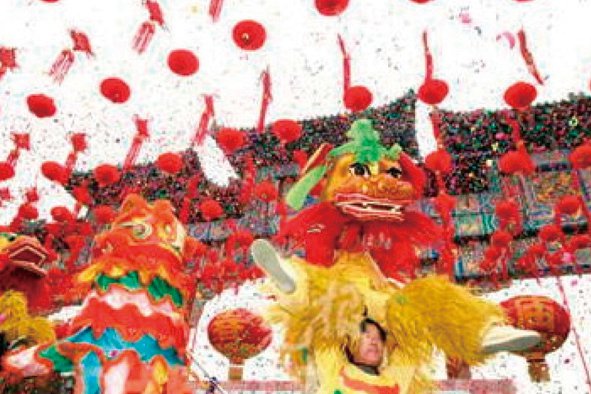Festivals in the World
China: Chinese Spring Festival (Chinese New Year)
Zhou Weiwei (Business School, 1st Year)
Of all the world's great celebrations, the traditional Chinese New Year or spring festival is possibly the largest. One of the fascinating and unique aspects of the Chinese New Year is the time in which it is held. Unlike Japan, the coming of the New Year is traditionally celebrated in the spring. The reason for this is the ancient use of the Lunar Calendar, which continues to this day.
The Chinese culture truly blossoms during these celebrations. Traditional performances take place throughout the entire country. One of the most widely known performances is the Lion Dance. The Lion Dance has an incredibly long tradition dating back to ancient China. Students from various martial art schools from all over the country perform this historical dance. There are also many different kinds of performances all over the country. Some of the other events include Xinzi (standing on stilts), carrying desks and other objects using only small pieces of bamboo.
On New Year's Eve, 60% to 70% of the Chinese population watch the New Year Special TV program. Much like the kouhaku in Japan, they use this time to get together with family. People who work outside of their hometown will come back to enjoy this moment with their loved ones. The New Year Special TV program starts at 8:00, and continues past 12:00. Chinese people who reside in other countries also get together to watch this cultural event and count down with the family.
After the countdown, celebrators shout a triumphant gHappy New Year!h to each other and light off firecrackers to welcome the New Year.
After the celebrations, people will usually go to sleep. But for children, it is really hard to sleep with the blasting sounds of firecrackers going on all night. For those who wish to enjoy a little bit more of firecrackers, I recommend getting some sleep while thoughts of tomorrow dance in your head.
For children, Chinese New Year means getting new clothes from head to toe. It also means delicious food, and playing with other children without being scolded. New Years represent the beginning of everything and Chinese parents believe scolding is not uspicious for this time of the year. Younger mothers tend to put off punishments until the observation of New Years is finished.
Another happy event for children is the Yasuiqian (money given to children as a lunar New Year gift). It is given by the elder members of the family or a friend of an elder. A general rule of thumb for children is the more people they visit during the holidays, the higher the chance it is to receive more money. Youngsters are known to continually ask if there is anyone else to visit. Children receive this gift until they have children of their own.
Like many other countries, China too has it's own traditional New Years food such as Nian gao. Nian gao can be translated to ghigher yearh and is one of the many dishes included in the ceremonies during the 15 days of New Years. The 15th is the last official day of the succession of celebration. On this final day, the Lantern festival or Chap Go Meh is held and families leave candles outside in order to guide sprits back to heaven. Families also stroll along the streets in honor of the auspicious day. All these details are an incredible and vital part to China's wonder and beauty. Any opportunity to experience this should not be missed. That is the Chinese Spring Festival - the biggest festival in China.


